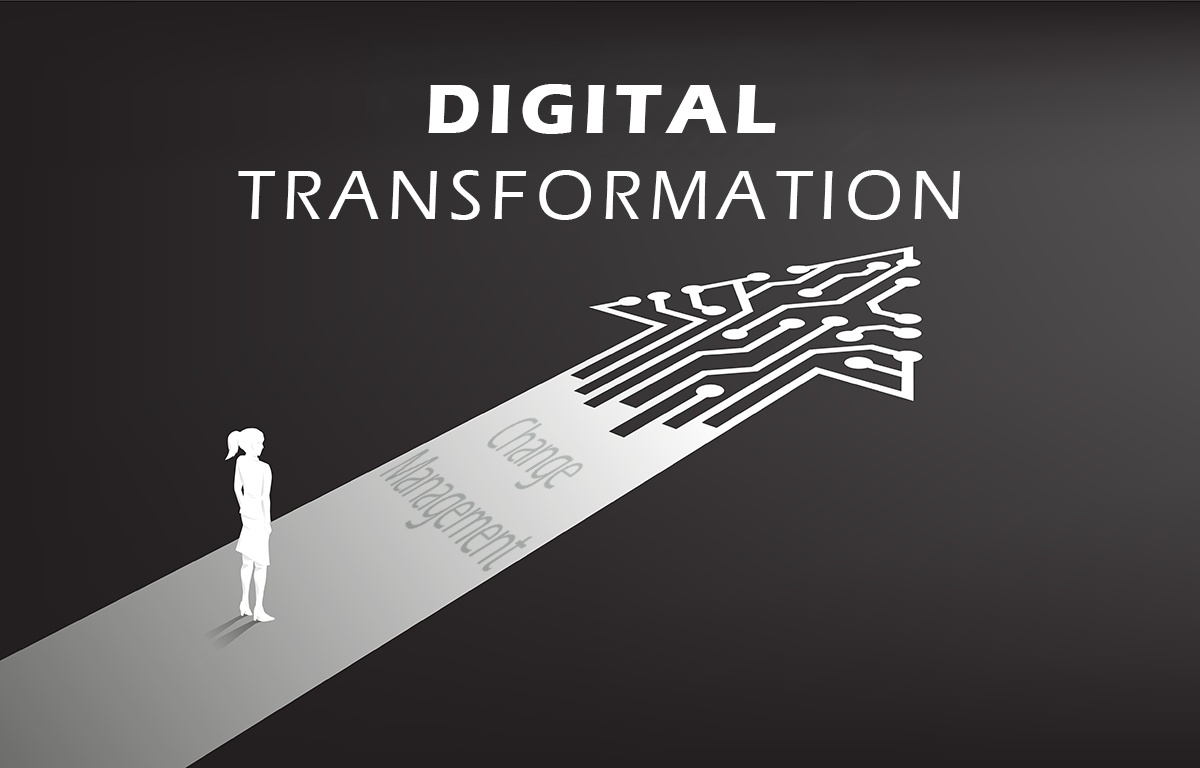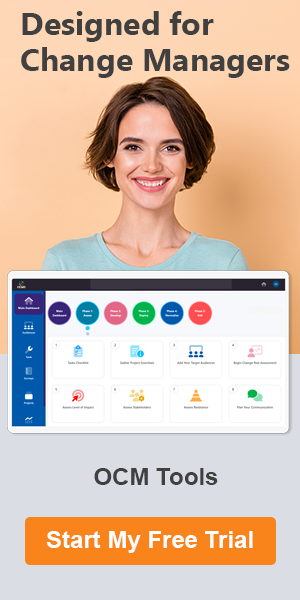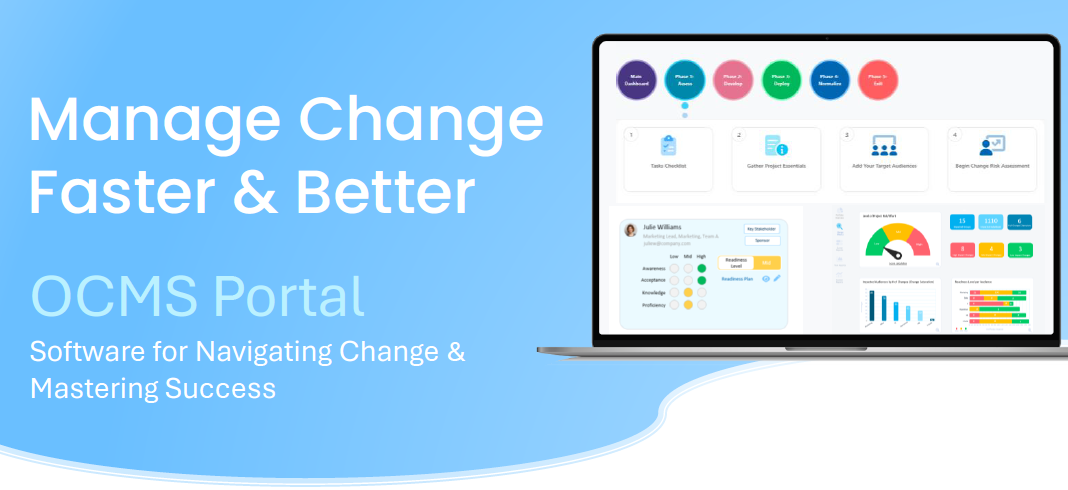Learn a Successful Change Management Strategy for Digital Transformation
Imagine your company is on the brink of a digital overhaul, poised to revolutionize operations and outpace competitors. Excitement fills the air, but soon reality sets in. Resistance surfaces, productivity dips, and the journey ahead seems daunting.
The digital age is relentless. New technologies emerge at breakneck speed, reshaping industries and customer expectations. Organizations that fail to adapt risk falling behind.
A digital transformation is more than just acquiring fancy new tools. It’s about people. Successful transformation hinges on the ability to guide your workforce through significant change. That’s where digital change management becomes your life raft, keeping you afloat and navigating the transformation journey effectively.

Join us as we explore the intricacies of digital transformation change management and unveil the power it holds in steering your organization toward success.
Watch a summary below:
Story Highlights
|
Why Change Management is Crucial for Digital Transformation
Imagine implementing a cutting-edge marketing automation platform. While the technology might be powerful, without proper organizational change management for digital transformation, employees might struggle to adapt their workflows, leading to frustrated users and wasted resources. Ultimately, you have a stalled transformation.
Effective change management helps you avoid this scenario by:
- Increasing User Adoption: Change management in digital transformation fosters understanding and encourages employees to embrace new technologies, leading to higher adoption rates and maximizing the ROI of digital tools.
- Minimizing Resistance: By addressing concerns and providing support, digital change management helps minimize resistance and create a smoother transition for everyone involved.
- Building Employee Confidence: Through training and support, employees feel equipped to navigate the new digital landscape. This boosts their confidence and fosters a sense of ownership in the change.
- Enhancing Communication and Collaboration: Digital transformation change management emphasizes clear and open communication, ensuring everyone receives crucial information and feels involved in the process.
- Promoting a Culture of Continuous Improvement: Successful digital adoption fosters a culture of learning and adaptation. A change management strategy for digital transformation provides the framework to embrace future changes with agility.
Do you have any questions about digital transformation organizational change strategies? Please reach out and let us know. We’re happy to help!
Your Digital Transformation and Change Management Toolkit
Here are the key tools to navigate change management and digital transformation successfully.
Clearly Defined Vision and Goals
Outline a clear vision for your digital transformation journey. What are you hoping to achieve? What is the difference in workflows and processes between the current state and the future state? Establish quantifiable goals to track progress and measure the impact of the changes.
Comprehensive Stakeholder Analysis
Identify all stakeholders impacted by the transformation – employees across departments, leaders, and even external partners. They will be the target audience for your change management & digital transformation strategy. Consider their needs and concerns when developing your change management plan.
Communication Strategy and Transparency
Develop a comprehensive communication plan outlining how you will inform stakeholders about the transformation. Maintain open and transparent communication throughout the process, addressing concerns proactively.
Training and Development Programs
Equip employees with the skills and knowledge they need to effectively utilize new technologies and adapt their work practices. Training programs should be tailored to different roles and learning styles as part of the digital transformation organizational change.
Ongoing Support Systems
Establish support systems such as help desks, knowledge bases, or peer mentorship programs to address questions and concerns as employees navigate the new digital landscape. This is important both before and after deployment of the solution to foster successful digital adoption.
Reinforcement and Recognition
Don’t let the momentum fade after initial implementation. Implement reinforcement strategies such as recognition programs for exemplary behavior, ongoing communication highlighting the benefits of the changes, and leader visibility demonstrating positive adoption of new digital tools.
Data-Driven Decision Making
Utilize data analytics capabilities of new digital tools to track progress, identify areas for improvement, and measure the impact of digital transformation change management on business performance.
Please let us know if you have any feedback or questions about change management and digital transformation. We’d love to hear from you!
Leading by Example: Fostering a Change-Ready Culture
Digital transformation success hinges on leadership. Leaders must champion the change, demonstrate the value of new technologies, and embody the desired behaviors. This includes:
- Clearly Communicating the Vision: Leaders must clearly articulate the purpose behind the digital transformation, motivating employees and gaining their buy-in.
- Leading by Example: Leaders who actively leverage the new technologies and model the desired behaviors send a powerful message to employees.
- Empowering Employees: Empowering employees to experiment with new tools and contribute towards optimizing workflows fosters a culture of ownership and continuous improvement.
- Building Trust and Transparency: Maintaining open communication channels and addressing concerns honestly builds trust and encourages employees to actively participate in the transformation journey.
- Support Digital Change Management: Employees may resist participating in change management activities, especially if this is new to them. Leaders should show visible support for change management in digital transformation and articulate its importance to the organization.
Addressing Resistance Proactively
Change can be unsettling. Some employees might feel resistant to the digital transformation and/or the digital transformation and change management strategy. Here’s how to address resistance proactively:
- Acknowledge Concerns: Listen empathetically to employee concerns and acknowledge the challenges associated with change.
- Focus on Benefits: Clearly communicate the benefits of the digital transformation and digital change management for both the organization and individual employees, highlighting opportunities for increased efficiency, improved work-life balance, and career growth.
- Address Skills Gaps: Identify skills gaps that might be impeding adoption and develop training programs to bridge those gaps. Empowering employees with the necessary skills reduces anxiety and fosters confidence.
- Celebrate Successes: Recognize and celebrate early wins achieved through the change management strategy for digital transformation. This reinforces the value of the change and motivates continued engagement.
The Agile Approach: Embracing Continuous Learning
The digital landscape is always evolving. Successful digital transformation requires an agile approach that embraces continuous learning and adaptation. Here’s how:
- Pilot Programs and Iterative Improvement: Consider implementing new technologies through pilot programs in smaller groups first. This allows you to refine your approach and identify potential challenges before a wider rollout.
- Feedback Mechanisms: Establish feedback mechanisms such as surveys and focus groups to gather employee feedback on the new technologies and processes. Utilize this feedback to continuously improve your training programs and support systems.
- Data-Driven Decision Making: Leverage data analytics capabilities of the new digital tools to track progress, identify areas for improvement, and measure the impact of the digital transformation on business performance. Data-driven insights inform strategic decisions and help you optimize.
Would you like monthly tips on topics like digital transformation and change management? Sign up for our OCMS newsletter here.
Conclusion: Change Management in Digital Transformation
Digital transformation is not a one-time event; it’s an ongoing voyage. By equipping yourself with a robust digital change management strategy and fostering a culture of continuous learning, you can navigate this journey with confidence.
Remember, the key is to engage your people, empower them with the skills & support they need, and celebrate their successes along the way. With a committed workforce embracing new technologies and a leadership team championing digital transformation and change management, your organization can harness the power of new tools to achieve sustainable growth and competitive advantage.
A Platform to Power Change Management and Digital Transformation
Your organization adopts new digital tools to improve the way you work. Don’t leave out change management software!
With time-saving automation and a simple, repeatable framework, the OCMS Portal change management platform is designed to make your life easier and empower successful digital adoption.
FAQ: Digital Transformation Change Management
Why is change management crucial for digital transformation?
While the technology might be powerful, without proper organizational change management for digital transformation, employees might struggle to adapt their workflows, leading to frustrated users and wasted resources.
What’s the first step in a change management strategy for digital transformation?
The first step in a plan for change management & digital transformation is to outline a clear vision for your digital transformation journey. Establish quantifiable goals to track progress and measure the impact of the changes.
Why is leadership support vital for change management in digital transformation?
Digital transformation success hinges on leadership. Leaders must champion the change, demonstrate the value of new technologies, and embody the desired behaviors. Otherwise, employees may not think the digital transformation is a priority and may revert to their more comfortable ways of doing things.
Note: Content on OCM Solution's ocmsolution.com website is protected by copyright. Should you have any questions or comments regarding this OCM Solutions page, please reach out to Ogbe Airiodion (Change Management Lead) or the OCM Solutions Team today. OCM Solution was previously known as Airiodion Global Services (AGS).
External Sources: stock.adobe.com





